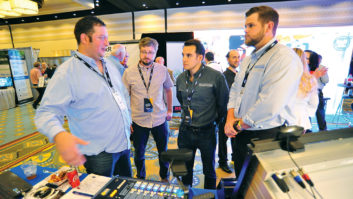Editor’s note: The window for filing applications for new LPFM stations has been pushed back. It will now run from Dec. 6 to Dec. 13. Learn more here.
Radio World has introduced a series of articles titled “Firing Up Frequencies,” intended for readers who may be interested in applying for a low-power FM station license in the FCC’s upcoming window in November 2023. The following story is the third installment in the series.
The author is Sharon Scott, president and co-founder of ART FM, WXOX in Louisville, Ky. Sharon is the author of the new book “Low-Power FM for Dummies.”

There is less than ONE MONTH to go before the FCC opens the magic window to building an FM radio station for your community. Nov. 1–8 marks the first time in an entire decade that local nonprofit organizations will have an opportunity to apply for a spot on the FM dial. In other words, LET’S GO!
There is absolutely no time to delay but, if you hustle, there is still time to make this happen. Community organizations who miss this portal when it opens, may never have the opportunity to step on to the FM dial again.
To determine if there is availability in your community you can use the FCC Channel Finder or the REC Networks LPFM Availability Map.
Arts organizations, historical societies, educational academies and other cultural institutions are all examples of nonprofit organizations that would make great applicants — and they should totally do it! There are so many educational opportunities to be had! If you don’t have a nonprofit, there is still time to incorporate with your state, but not very much. To do this, visit your Secretary of State website for a possible online form or consult with your attorney.
This is a straightforward process but, as you can imagine, the FCC has a few requirements for the organizations that hold LPFM licenses. Check my previous Radio World articles “Get Ready to Fire Up the LPFM Frequencies” to get an overview of the application process and “Taking It LPFM: Finding or Founding Your Nonprofit” to make sure you have a nonprofit that is in good standing to apply. Groups that have been incorporated over two years will get a bonus point that will be unnecessary in rural areas but critical in urban spaces where there is not much space on the dial.
Once you have determined that there is availability for an LPFM in your area, and you have found (or created) a nonprofit organization to submit the application, you should connect with a radio engineer right away. Look for someone with LPFM experience as there are particular rules and guidelines this class of operators need to follow. While it may not be necessary for all applicants to work with an engineer, it is highly recommended. This is a one-shot deal. If you mess up on a technical detail, your application may be dismissed entirely.
LPFM groups with legal and engineering expertise that are still taking clients include the nonprofits Common Frequency and International Media Action. Michael Brown of Brown Broadcast Services has stated that he will continue accepting clients through this year’s Grassroots Radio Conference (GRC). Pete Tridish of the nonprofit organization International Media Action is another helpful resource.
Speaking of GRC, you will not want to miss out on this year’s gathering of college and community radio activists in Charleston, W.V., this Oct. 19–22, hosted by WTSQ(LP). Since this year’s conference will be just ahead of the LPFM window, it will be a great opportunity for new applicants to learn the ropes and meet some important radio colleagues.
The LPFM Resources website is a launching pad for those with an interest in starting an LPFM station but don’t know much about it. As the author of LPFM for Dummies, I pulled this site together with input from Common Frequency and REC Networks as a means for getting critical info out to nonprofits nationwide prior to the book hitting the shelves — which, fingers crossed, could happen as soon as this week! I hope everyone in the Community Radio community will find it a helpful guide to building and sustaining an LPFM radio station. The idea is to make it easy and let folks know that they can do it!
For the month of October, those interested in community media should focus on one project and one project only, encouraging local nonprofit organizations to apply for Low-Power FM licenses. It is important that the organizational leaders know they will have more than three years to build their station. Right now they don’t have to know exactly how the programing will sound or how they are going to finance the operation. If those details don’t end up working out, they can transfer the license to another nonprofit organization and keep the frequency in the hands of the community.
Otherwise, they will be lost forever.
Todd Urick of Common Frequency, Wade Rathke of ACORN International and William King of KOWN(LP) are leading the charge in seeking out nonprofit organizations to apply for these low power licenses in areas that have no community radio outlets. Common Frequency is seeking advocates with an interest in connecting with nonprofits in target areas and letting them know about the LPFM opportunity.
As the FCC application window approaches, they will need volunteers to help process some of the information. If you are interested in joining the team, please contact Todd at Common Frequency by emailing [email protected].
The Low-Power FM opportunity is quickly approaching and there is absolutely zero time to spare! If you want to apply, get started now! Like RIGHT NOW. If you are community media advocate, anything you can do to help get the word out will really help. Once the November LPFM window has passed us by, it may be a very long time before community voices have such an opportunity again.
[Related: “Taking It LPFM: Finding or Founding Your Nonprofit“]










